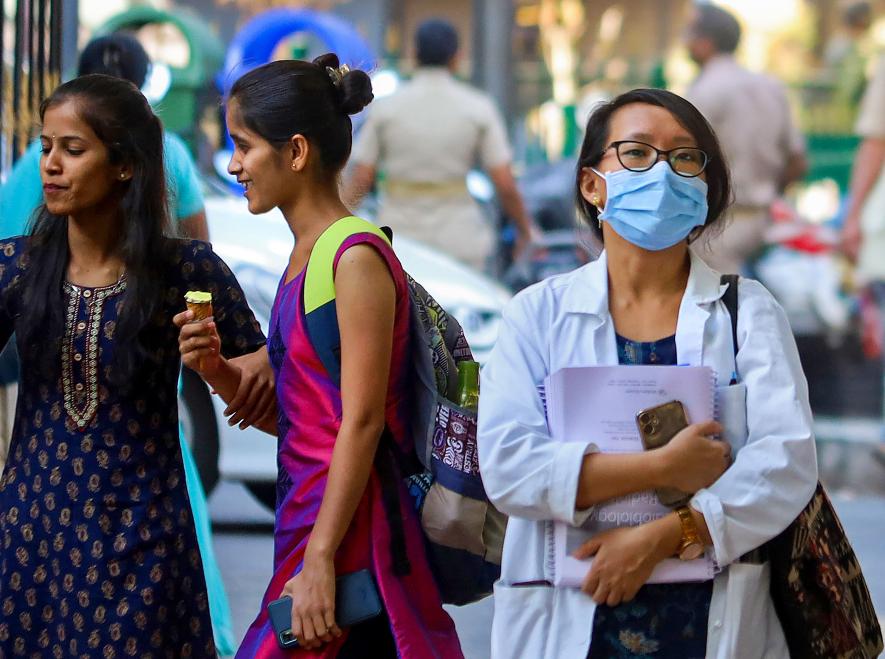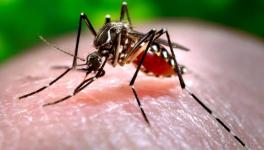‘No Evidence That H3N2 is Spreading Too Much in India,’ Says Expert

A medical student wears a mask for protection against diseases including H3N2 and Covid virus, at a government hospital, in Bengaluru, Friday, Mar 10, 2023. Image Courtesy: PTI
The spread of the influenza virus, especially after the reports of two deaths, one in Karnataka and another in Haryana, is raising concerns. This time, the deaths and, for that matter, the disease is caused by the Influenza A subtype H3N2 virus. Till now, nearly 100 cases have been reported across the country.
The Indian Council of Medical Research (ICMR) recently announced the presence of H3N2 in various parts of the country, where the infected people suffered from a cough for a week and a fever.
The influenza virus causes one of the most common respiratory diseases in the world. Influenza viruses are mainly of four types—Influenza A, Influenza B, Influenza C and Influenza D, with each type having more subtypes. The H3N2 is a subtype of the Influenza A virus. The symptoms of having infected by it are the same as in common flu—runny nose, sore throat, cough, fever, body ache etc. The symptoms last for about a week, and patients commonly recover within that time, but a cough sometimes remains for weeks. However, in less common situations, the disease can become more severe.
Then the question that arises is why there is media hype surrounding it. Has the disease spread higher than in previous years, and is there any real chance of the disease spreading more in the near future?
Speaking to NewsClick, Satyajit Rath, noted immunologist and adjunct faculty at IISER Pune, said, “H3N2 viruses are yet another variety of influenza A viruses. So far, I have not seen any evidence that there is a huge surge of H3N2 cases. There seems to be evidence that many, perhaps a majority of influenza A cases tested, are H3N2. This is not surprising since influenza A virus varieties frequently change year by year.”
“I suppose part of the reason for the media attention is simply that we are all, the world over, somewhat sensitive to viral illnesses spreading,” Prof Rath added.
Reportedly, the latest IDSP-IHIP (Integrated Health Information Platform) data suggests that a total of 3,038 cases have been confirmed in laboratories till March 9. These are caused by a variety of subtypes of the Influenza virus, which includes the H3N2 as well. The monthly break-up of the total cases is 1,245 in January, 1,307 in February, and 486 in March.
If the cases in India are really higher this year, then are there factors like viral evolution, weather or climatic conditions, or the high rise of pollution linked to it? On it, Prof Rath told NewsClick, “While all of these are plausible factors, none of them is specific to this year, it seems to me. Also, influenza viruses change more rapidly than coronaviruses do, so new varieties are not unexpected at all.”
Considering the severity of the disease, especially the reported death toll, it becomes pertinent to ask How common is it that H3N2 can travel to the lower respiratory system and cause severe respiratory problems that need ICU care?
Again, Prof Rath commented saying, “There does not seem to be any evidence so far that H3N2 influenza A viruses cause serious disease with any greater frequency than other influenza A viruses.”
According to the Indian Medical Association (IMA), people below 15 years and above 50 years are more vulnerable to the virus. Moreover, people having other conditions like asthma, diabetes, heart disease, neurological conditions, and weak immunity may be at a higher risk. Hence, they need to be extra cautious about keeping themselves away from the virus as much as possible. For this, the regular habits of mask-wearing, hand washing, and avoiding crowded places are advisable, according to doctors.
Viruses undergo rapid evolution by means of mutations (random changes in their genetic material, that is, either the DNA or the RNA). The influenza virus also undergoes evolutionary changes; monitoring it is an important part of disease prevention. It is also because some changes in its genetic material can render the virus to be more dangerous.
Tracking the evolutionary traits of the virus is necessary so that any possible big waves can be prevented in the future. Further, respiratory viruses are fast evolving. When asked about Prof Rath’s views on the status of such genome sequencing efforts in India, he said, “Changes in the prevalent influenza A viruses can be tracked to a significant extent without full genome sequencing. It simply needs well-organised consistent disease surveillance and a robust public health care system.”
He further said, “It is of course worthwhile to ask if we in India do have these to an adequate extent.” He added that the changes in influenza virus varieties are monitored globally by a long-standing international collaborative tracking system and are linked to annual influenza vaccine design decisions.
Get the latest reports & analysis with people's perspective on Protests, movements & deep analytical videos, discussions of the current affairs in your Telegram app. Subscribe to NewsClick's Telegram channel & get Real-Time updates on stories, as they get published on our website.
























